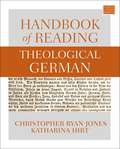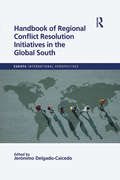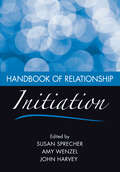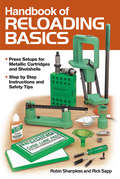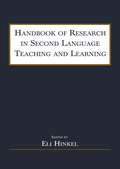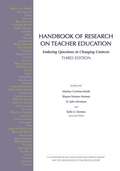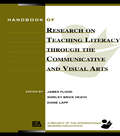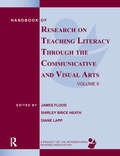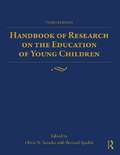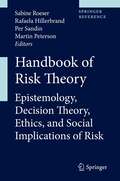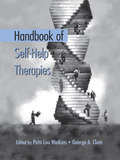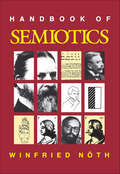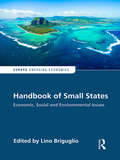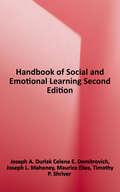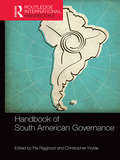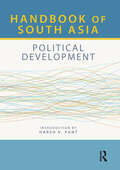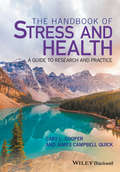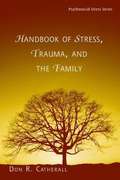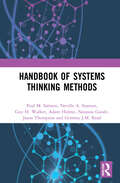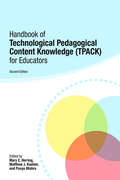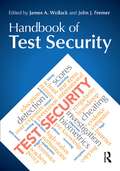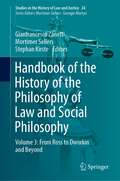- Table View
- List View
Handbook of Racism, Xenophobia, and Populism: All Forms of Discrimination in the United States and Around the Globe (Springer Handbooks of Political Science and International Relations)
by Adebowale AkandeThis handbook presents the roots of symbolic racism as partly in both anti-black antagonism and non-racial conservative attitudes and values, representing a new form of racism independent of older racial and political attitudes. By doing so, it homes in on certain historical incidents and episodes and presents a cogent analysis of anti-black, Jim Crowism, anti-people of color (Black, Latino, Native Americans), and prejudice that exists in the United States and around the world as a central tenet of racism. The book exposes the reader to the nature and practice of stereotyping, negative bias, social categorization, modern forms of racism, immigration law empowerment, racialized incarceration, and police brutality in the American heartland. It states that several centuries of white Americans’ negative socializing culture marked by widespread negative attitudes toward African Americans, are not eradicated and are still rife. Further, the book provides a panoramic view of trends of racial discrimination and other negative and desperate challenges that Black, Indigenous, and People of Color face across the world. Finally, the volume examines xenophobia, racism, prejudice, and stereotyping in different contexts, including topics such as Covid-19, religion and racism, information manipulation, and populism. The book, therefore, is a must-read for students, researchers, and scholars of political science, psychology, history, sociology, communications/media studies, diplomatic studies, and law in general, as well as ethnic and racial studies, American politics, global affairs, populism, and discrimination in particular.
Handbook of Reading Theological German
by Christopher Ryan Jones Katharina HirtThe Handbook of Reading Theological German is the premier resource for equipping those interested in reading and translating original German source materials and preparing academics for German comprehension examination. The book is ideal for students in biblical studies, church history, Jewish studies, and theology. Coauthored by Katharina Hirt, a native German speaker and professional linguist, and Christopher Ryan Jones, a native English speaker and doctoral candidate in biblical studies, this collaboration draws on the latest developments in linguistics to present a cutting-edge teaching methodology for graduate students learning to read German for research.Attuned to the specific needs of English speakers learning German, this handbook is well suited for independent study or for use in the classroom. Providing abundant exercises and readings, Jones and Hirt&’s work provides an excellent entry point for students required to learn theological German.The Handbook of Reading Theological German provides:An introduction to German grammarA demonstration of the role that German theology has had in the development of modern Jewish and Christian practices.Guided readings and biographies of six major German theologians and philosophersFurther, advanced readings with minimal guidance from contemporary authors in the areas of Hebrew Bible, New Testament, Jewish studies, church history, and theology, so that students can focus on literature from their chosen field of study
Handbook of Regional Conflict Resolution Initiatives in the Global South (Europa International Perspectives)
by Jerónimo Delgado-CaicedoDuring the first half of the twentieth century, the international system was largely dominated by the USA and the colonial powers of western Europe. After the two world wars, the political and economic dominance of these states guaranteed them and their allies an almost complete control of world politics. However, as it is the norm in the international system, power structures are not immutable. After the end of the Cold War, rapid changes to the existing international hierarchies took place, as new countries from the so-called ‘‘developing world’’ began to emerge as crucial actors capable of questioning and altering the power dynamics of the world. It is therefore unthinkable to ignore emerging countries such as Russia, the People’s Republic of China, India, Brazil or South Africa in the decision-making process in today’s world order. In addition, there is a group of smaller, yet increasingly important countries that, while acknowledging their inability radically to change the rules of the international system, are still eager to shift power relations and enhance their influence in the world. Argentina, Colombia, Egypt, Indonesia, Iran, South Korea, Mexico, Nigeria, Pakistan, Saudi Arabia, Turkey and Vietnam are generally recognised as part of this grouping of emerging powers from the Global South. While there is a consensus amongst academics that emerging powers from the Global South must have a stabilising role within their own regions, previous analyses have focused primarily on the impact that emerging powers have had in their own regions’ conflict resolution initiatives. This volume, instead, aims to go beyond these analyses and provide new insights regarding the effect that this stabilising role has on the continental and global positioning of emerging powers. In other words, this book explores the relation between a country’s involvement in conflict resolution initiatives and its positioning in the international system. The volume will contribute to this approach using the perspective of academics and practitioners from countries of the Global South, particularly from states that have strengthened - or sometimes weakened - their position in the international hierarchy of power through a leading role in regional conflict resolution initiatives.
Handbook of Relationship Initiation
by John Harvey Amy Wenzel Susan SprecherThe Handbook of Relationship Initiation is the first volume to focus specifically on the very beginning stage of relationships – their origin. In this Handbook, leading scholars on relationships review the literature on various processes related to the initiation of relationships: how people meet, communicate for the first time, and begin to define themselves as being in a relationship. Topics include attraction, mate selection, influence of social networks on relationship initiation, initiation over the internet, hook-ups among young adults, and flirting and opening gambits. In addition, the dark side of relationship initiation is considered, including unwanted relationship pursuit and barriers to relationship initiation including social anxiety. This volume provides an overdue synthesis of the literature on this topic. It is especially timely in view of the growing prevalence on relationship initiation online, through matchmaking and other social networking sites, which has increased awareness that science can be used to understand, create, and facilitate compatible matching. This Handbook provides an essential resource for an interdisciplinary range of researchers and students who study relationships, including social psychologists, communication scientists and scholars of marriage and the family.
Handbook of Reloading Basics
by Rick Sapp Robin SharplessReady, set, reload! With ammo shortages on retailer's shelves, unprecedented firearms sales across the country, and burgeoning numbers of new shooters, reloading is growing in leaps and bounds. Handbook of Reloading Basics, written by industry experts Robin Sharpless and Rick Sapp, is aimed squarely at the new handloaders and simplifies both the equipment and the process. Inside this bench-handy reference you'll find: Step-by-step instructions for reloading metallic cartridges and modern shotshells Press selection--single-stage, turrets and progressives explained Component breakdown--primers, cases, hulls, powder, wads and bullets Dozens of illustrative photos and a comprehensive resource listing. Before you buy your first press, before you polish your brass or sort your shotshell hulls you must read Handbook of Reloading Basics. This invaluable reference is the one to get you started and keep you loading round after round.
Handbook of Research in Second Language Teaching and Learning: Volume 2 (Esl And Applied Linguistics Professional Ser.)
by Eli HinkelThis landmark volume provides a broad-based, state-of-the-art overview of current knowledge and research into second language teaching and learning. Fifty-seven chapters are organized in eight thematic sections:*social contexts of second language learning;*research methodologies in second-language learning, acquisition, and teaching;*contributions of applied linguistics to the teaching and learning of second language skills;*second language processes and development;*teaching methods and curricula;*issues in second or foreign language testing and assessment;*identity, culture, and critical pedagogy in second language teaching and learning; and*important considerations in language planning and policies.The Handbook of Research in Second Language Teaching and Learning is intended for researchers, practitioners, graduate students, and faculty in teacher education and applied linguistics programs; teachers; teacher trainers; teacher trainees; curriculum and material developers; and all other professionals in the field of second language teaching and learning.
Handbook of Research on Science Education
by Norman G. Lederman Sandra K. AbellThis state-of-the art research Handbook provides a comprehensive, coherent, current synthesis of the empirical and theoretical research concerning teaching and learning in science and lays down a foundation upon which future research can be built. The contributors, all leading experts in their research areas, represent the international and gender diversity that exists in the science education research community. As a whole, the Handbook of Research on Science Education demonstrates that science education is alive and well and illustrates its vitality. It is an essential resource for the entire science education community, including veteran and emerging researchers, university faculty, graduate students, practitioners in the schools, and science education professionals outside of universities. The National Association for Research in Science Teaching (NARST) endorses the Handbook of Research on Science Education as an important and valuable synthesis of the current knowledge in the field of science education by leading individuals in the field. For more information on NARST, please visit: http://www.narst.org/.
Handbook of Research on Teacher Education: Enduring Questions in Changing Contexts
by Marilyn Cochran-Smith Sharon Feiman-Nemser D. John McIntyre Kelly E. DemersCo-Published by Routledge/Taylor & Francis Group and the Association of Teacher Educators. The Handbook of Research on Teacher Education was initiated to ferment change in education based on solid evidence. The publication of the First Edition was a signal event in 1990. While the preparation of educators was then – and continues to be – the topic of substantial discussion, there did not exist a codification of the best that was known at the time about teacher education. Reflecting the needs of educators today, the Third Edition takes a new approach to achieving the same purpose. Beyond simply conceptualizing the broad landscape of teacher education and providing comprehensive reviews of the latest research for major domains of practice, this edition: stimulates a broad conversation about foundational issues brings multiple perspectives to bear provides new specificity to topics that have been undifferentiated in the past includes diverse voices in the conversation. The Editors, with an Advisory Board, identified nine foundational issues and translated them into a set of focal questions: What’s the Point?: The Purposes of Teacher Education What Should Teachers Know? Teacher Capacities: Knowledge, Beliefs, Skills, and Commitments Where Should Teachers Be Taught? Settings and Roles in Teacher Education Who Teaches? Who Should Teach? Teacher Recruitment, Selection, and Retention Does Difference Make a Difference? Diversity and Teacher Education How Do People Learn to Teach? Who’s in Charge? Authority in Teacher Education How Do We Know What We Know? Research and Teacher Education What Good is Teacher Education? The Place of Teacher Education in Teachers’ Education. The Association of Teacher Educators (ATE) is an individual membership organization devoted solely to the improvement of teacher education both for school-based and post secondary teacher educators. For more information on our organization and publications, please visit: www.ate1.org
Handbook of Research on Teaching Literacy Through the Communicative and Visual Arts: Sponsored by the International Reading Association
by James Flood Diane Lapp Shirley Brice HeathIn an era characterized by the rapid evolution of the concept of literacy, the Handbook of Research on Teaching Literacy Through the Communicative and Visual Arts focuses on multiple ways in which learners gain access to knowledge and skills. The handbook explores the possibilities of broadening current conceptualizations of literacy to include the full array of the communicative arts (reading, writing, speaking, listening, viewing) and to focus on the visual arts of drama, dance, film, art, video, and computer technology. The communicative and visual arts encompass everything from novels and theatrical performances to movies and video games. In today's world, new methods for transmitting information have been developed that include music, graphics, sound effects, smells, and animations. While these methods have been used by television shows and multimedia products, they often represent an unexplored resource in the field of education. By broadening our uses of these media, formats, and genres, a greater number of students will be motivated to see themselves as learners. In 64 chapters, organized in seven sections, teachers and other leading authorities in the field of literacy provide direction for the future: I. Theoretical Bases for Communicative and Visual Arts Teaching Paul Messaris, Section Editor II. Methods of Inquiry in Communicative and Visual Arts Teaching Donna Alvermann, Section Editor III. Research on Language Learners in Families, Communities, and Classrooms Vicki Chou, Section Editor IV. Research on Language Teachers: Conditions and Contexts Dorothy Strickland, Section Editor V. Expanding Instructional Environments: Teaching, Learning, and Assessing the Communicative and Visual Arts Nancy Roser, Section Editor VI. Research Perspectives on the Curricular, Extracurricular, and Policy Perspectives James Squire, Section Editor VII. Voices from the Field Bernice Cullinan and Lee Galda, Section Editors The International Reading Association has compiled in the Handbook of Research on Teaching Literacy Through the Communicative and Visual Arts an indispensable set of papers for educators that will enable them to conceptualize literacy in much broader contexts than ever before. The information contained in this volume will be extremely useful in planning literacy programs for our students for today and tomorrow.
Handbook of Research on Teaching Literacy Through the Communicative and Visual Arts, Volume II: A Project of the International Reading Association
by James Flood Shirley Brice Heath Diane LappThe Handbook of Research on Teaching Literacy Through the Communicative and Visual Arts, Volume II brings together state-of-the-art research and practice on the evolving view of literacy as encompassing not only reading, writing, speaking, and listening, but also the multiple ways through which learners gain access to knowledge and skills. It forefronts as central to literacy education the visual, communicative, and performative arts, and the extent to which all of the technologies that have vastly expanded the meanings and uses of literacy originate and evolve through the skills and interests of the young. A project of the International Reading Association, published and distributed by Routledge/Taylor & Francis. Visit http://www.reading.org for more information about Internationl Reading Associationbooks, membership, and other services.
Handbook of Research on the Education of Young Children
by Olivia N. Saracho Bernard SpodekThe Handbook of Research on the Education of Young Children is the essential reference on research on early childhood education throughout the world. This singular resource provides a comprehensive overview of important contemporary issues as well as the information necessary to make informed judgments about these issues. The field has changed significantly since the publication of the second edition, and this third edition of the handbook takes care to address the entirety of vital new developments. A valuable tool for all those who work and study in the field of early childhood education, this volume addresses critical, cutting edge research on child development, curriculum, policy, and research and evaluation strategies. With a multitude of new and updated chapters, The Handbook of Research on the Education of Young Children, 3rd Edition makes the expanding knowledge base related to early childhood education readily available and accessible.
Handbook of Risk Theory
by Per Sandin Rafaela Hillerbrand Sabine Roeser Martin PetersonRisk has become one of the main topics in fields as diverse as engineering, medicine and economics, and it is also studied by social scientists, psychologists and legal scholars. But the topic of risk also leads to more fundamental questions such as: What is risk? What can decision theory contribute to the analysis of risk? What does the human perception of risk mean for society? How should we judge whether a risk is morally acceptable or not? Over the last couple of decades questions like these have attracted interest from philosophers and other scholars into risk theory. This handbook provides for an overview into key topics in a major new field of research. It addresses a wide range of topics, ranging from decision theory, risk perception to ethics and social implications of risk, and it also addresses specific case studies. It aims to promote communication and information among all those who are interested in theoetical issues concerning risk and uncertainty. This handbook brings together internationally leading philosophers and scholars from other disciplines who work on risk theory. The contributions are accessibly written and highly relevant to issues that are studied by risk scholars. We hope that the Handbook of Risk Theory will be a helpful starting point for all risk scholars who are interested in broadening and deepening their current perspectives.
Handbook of Self-Help Therapies
by Patti Lou Watkins George A. ClumThis volume constitutes the first solidly research-grounded guide for practitioners wending their way through the new maze of self-help approaches. The Handbook of Self-Help Therapies summarizes the current state of our knowledge about what works and what does not, disorder by disorder and modality by modality. Among the covered topics are: self-regulation theory; anxiety disorders; depression; childhood disorders; eating disorders; sexual dysfunctions; insomnia; problem drinking; smoking cessation; dieting and weight loss. Comprehensive in its scope, this systematic, objective assessment of self-help treatments will be invaluable for practitioners, researchers and students in counseling psychology, psychiatry and social work, health psychology, and behavioral medicine.
Handbook of Semiotics (Advances in Semiotic)
by Winfried Nöth"This is the most systematic discussion of semiotics yet published." —Choice"A bravura performance." —Thomas Sebeok"Nöth's handbook is an outstanding encyclopedia that provides first-rate information on many facets of sign-related studies, research results, and applications." —Social Sciences in General
Handbook of Small States: Economic, Social and Environmental Issues (Europa Perspectives: Emerging Economies)
by Lino BriguglioThis handbook covers a wide spectrum of issues relating to small states. Chapters in the volume have been grouped under the three main themes of economic, social and environmental issues. The economics sections include chapters dealing with trade, finance and regulatory frameworks, while the social theme covers health, migration, population ageing, as well as overall social wellbeing. The environmental theme examines matters such as measuring environmental performance, natural disasters, the ocean economy, and the validity of the Sustainable Development Goals. One major issue is the definition of small states. As this volume demonstrates, generally speaking, population is used to measure country size in the literature. However, it clearly emerges that there is no real consensus as to the population cut-off point that distinguishes small states from large ones. While the approaches taken by the authors vary, in all cases the chapters draw practical policy implications for small states. The book can therefore be considered as a wide-ranging depositary of information on small states with the aim of deriving policy prescriptions, and thus as an excellent resource for academics, students and policymakers.
Handbook of Social and Emotional Learning, 2nd Edition
by Joseph A. Durlak Celene E. Domitrovich Joseph L. MahoneyThe definitive work on social and emotional learning (SEL) research and practice is now in an extensively revised second edition, featuring all new and thoroughly updated chapters. The world’s leading SEL scholars describe state-of-the-art interventions that build students' competencies for managing emotions, showing empathy for others, forming supportive relationships, and making responsible decisions. The scientific underpinnings of SEL are explored and its impact on academic achievement and behavior is examined. The Handbook discusses ways to assess SEL and design effective, developmentally and culturally informed programs for students in preschool through secondary school settings and beyond. New to This Edition *Reflects a decade of significant advances in research, policy, and implementation. *New and expanded topics--equity, culturally responsive practice, multi-tiered systems of support, adult SEL, technology tools and applications, mental health, scaling up successful interventions, and more. *Six chapters on international SEL efforts, discussing both developed and developing countries. *Every chapter concludes with Key Takeaway Points.
Handbook of South American Governance (Routledge International Handbooks)
by Pia Riggirozzi Christopher WyldeGovernance in South America is signified by strategies pursued by state and non-state actors directed to enhancing (some aspect of) their capabilities and powers of agency. It is about the spaces and the practices available, demanded or created to ‘make politics happen’. This framework lends explanatory power to understand how governance has been defined and practiced in South America. Pía Riggirozzi and Christopher Wylde bring together leading experts to explore what demands and dilemmas have shaped understanding and practice of governance in South America in and across the region. The Handbook suggests that governance dilemmas of inequitable and unfulfilled political economic governance in South America have been constant historical features, yet addressed and negotiated in different ways. Building from an introduction to key issues defining governance in South America, this Handbook proceeds to examine institutions, actors and practices in governance focusing on three core processes: evolution of socio-economic and political justice claims as central to the demands of governance; governance frameworks foregrounding particular issues and often privileging particular forms of political practice; and iterative and cumulative processes leading to new demands of governance addressing recognition and identity politics. This Handbook will be a key reference for those concerned with the study of South America, South American political economy, regional governance, and the politics of development.
Handbook of South Asia: Political Development
This Handbook brings together essays that introduce the reader to the key issues in South Asian political development. Written by experts in their respective areas, the essays explore key aspects of political economy, political and economic change, and the complex diplomatic and security challenges of individual countries and the region as a whole. Essays discuss topics as wide-ranging as China’s growing reach in South Asia, political Islam, SAARC and water politics through the region. This well-researched Handbook is an essential reference tool for students and scholars of Political Science, International Relations and South Asian studies.With an introduction by Harsh V Pant.
The Handbook of Stress and Health: A Guide to Research and Practice
by Cary L. CooperA comprehensive work that brings together and explores state-of-the-art research on the link between stress and health outcomes. Offers the most authoritative resource available, discussing a range of stress theories as well as theories on preventative stress management and how to enhance well-being Timely given that stress is linked to seven of the ten leading causes of death in developed nations, yet paradoxically successful adaptation to stress can enable individuals to flourish Contributors are an international panel of authoritative researchers and practitioners in the various specialty subjects addressed within the work
Handbook Of Stress, Trauma, And The Family (Routledge Psychosocial Stress)
by Don R. CatherallThe Handbook of Stress, Trauma, and the Family is broken down into three sections, compiling research, theory and practice. The first section focuses on how traumatic stress affects intimate others, what familial characteristics affect individual susceptibility to trauma, as well as evaluation of the effectiveness of various interventions. The section on theory explores concepts of stress and intrapsychic processes underlying the intergenerational transmission of trauma, addressesing how families can buffer or enhance anxiety. The final section, entitled practice, covers assessment (presenting both the Circumplex Model and Bowenian family theory models), treatment models and treatment formats for specific populations. The major family treatment models applicable to stress and trauma are discussed, including contextual, object relations, emotionally focused and critical interaction therapy.
Handbook of Systems Thinking Methods
by Paul M. Salmon Neville A. Stanton Guy H. Walker Adam Hulme Natassia Goode Jason Thompson Gemma J.M. ReadThe systems thinking philosophy has become popular in human factors and ergonomics and safety science. These methods are being used to understand and resolve complex societal problems in areas such as transport safety, workplace safety, medication error, disaster management, child abuse, financial crises, terrorism, climate change and public health and wellbeing. This handbook presents practical step-by-step guidance for practitioners and researchers wishing to use these methods to tackle complex problems. Each method includes an example case study which demonstrates how the method can be applied and how the results can be interpreted and translated into practical recommendations. The book presents practical guidance on state-of-the-art systems thinking methods and offers case study applications describing systems thinking methods in novel areas. It explains how to translate the outputs of systems thinking methods in practice and introduces systems thinking with an overview of Human Factors and Ergonomics applications. This book will serve as a great reference for students and engineers in the field of systems engineering, complex systems and the design and development of systems, including ergonomics/human factors and systems engineers, designers, architects, industrial engineers, project management engineers, reliability engineers, risk engineers, software engineers and computer engineers.
Handbook of Technological Pedagogical Content Knowledge (TPACK) for Educators
by Mary C. Herring, Matthew J. Koehler and Punya MishraThe 2nd edition of the Handbook of Technological Pedagogical Content Knowledge (TPACK) for Educators addresses the concept and implementation of technological pedagogical content knowledge—the knowledge and skills that teachers need in order to integrate technology meaningfully into instruction in specific content areas. Driven by the growing influence of TPACK on research and practice in both K-12 and higher education, the 2nd edition updates current thinking about theory, research, and practice. Offering a series of chapters by scholars in different content areas who apply the technological pedagogical content knowledge framework to their individual content areas, the volume is structured around three themes: Current thoughts on TPACK Theory Research on Technological Pedagogical Content Knowledge in Specific Subject Areas Integrating Technological Pedagogical Content Knowledge into Teacher Education and Professional Development The Handbook of Technological Pedagogical Content Knowledge (TPACK) for Educators is simultaneously a mandate and a manifesto on the engagement of technology in classrooms.
Handbook of Test Security
by James A. Wollack John J. FremerHigh stakes tests are the gatekeepers to many educational and professional goals. As such, the incentive to cheat is high. This Handbook is the first to offer insights from experts within the testing community, psychometricians, and policymakers to identify and develop best practice guidelines for the design of test security systems for a variety of testing genres. Until now this information was scattered and often resided inside testing companies. As a result, rather than being able to learn from each other’s experiences, each testing entity was left to re-create their own test security wheel. As a whole the book provides invaluable insight into the prevalence of cheating and “best practices” for designing security plans, training personnel, and detecting and investigating misconduct, to help develop more secure testing systems and reduce the likelihood of future security breaches. Actual case studies from a variety of settings bring to life how security systems really work. Examples from both domestic and international programs are provided. Highlights of coverage include:• Best practices for designing secure tests• Analysis of security vulnerabilities for all genres of testing• Practical cheating prevention and detection strategies• Lessons learned in actual security violations in high profile testing programs. Part I focuses on how tests are delivered for paper-and-pencil, technology-based, and classroom testing and writing assessment. Each chapter addresses the prevalence of the problem and threats to security, prevention, and detection. Part II addresses issues essential to maintaining a secure testing program such as planning and monitoring, physical security, the detection of group-based cheating, investigating misconduct, and communicating about security-related issues. Part III examines actual examples of cheating-- how the cheating was done, how it was detected, and the lessons learned. Part III provides insight into security issues within each of the Association of Test Publishers’ four divisions: certification/licensure, clinical, educational, and industrial/organizational testing. Part III’s conclusion revisits the issues addressed in the case studies and identifies common themes. Intended for organizations, professionals, educators, policy makers, researchers, and advanced students that design, develop, or use high stakes tests, this book is also ideal for graduate level courses on test development, educational measurement, or educational policy.
Handbook of the History of the Philosophy of Law and Social Philosophy: Volume 3: From Ross to Dworkin and Beyond (Studies in the History of Law and Justice #24)
by Gianfrancesco Zanetti Mortimer Sellers Stephan KirsteThis Handbook discusses representative philosophers in the history of the philosophy of law and social philosophy, giving clear concise expert definitions and explanations of key personalities and their ideas. It provides an essential reference for experts and newcomers alike.

